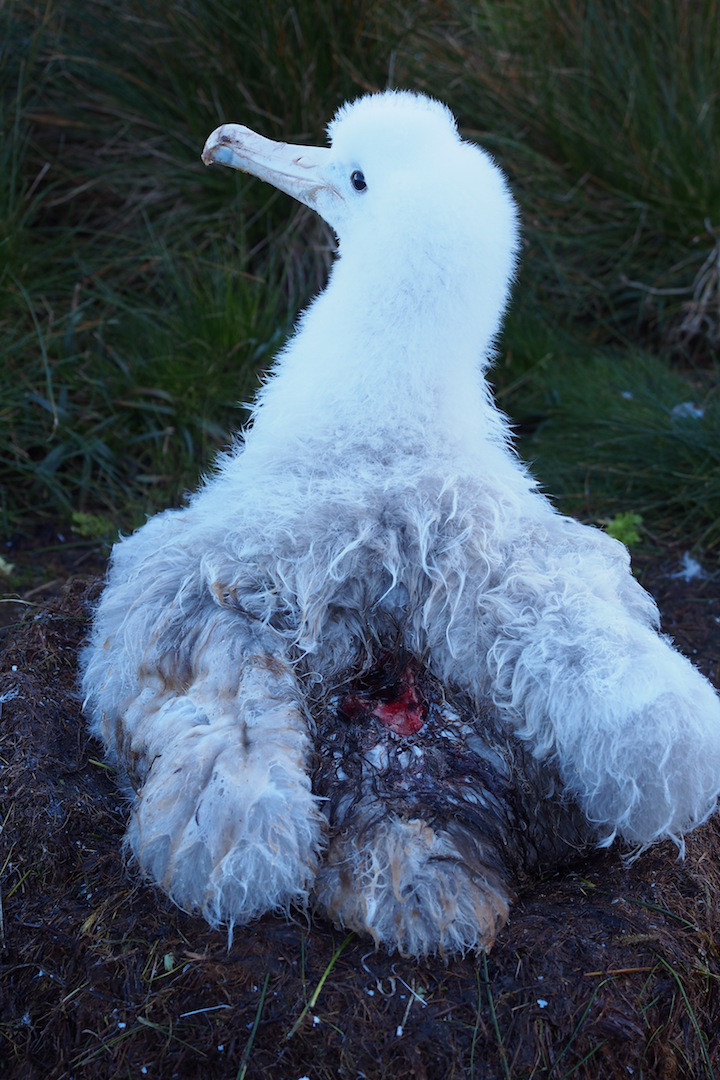
A Tristan Albatross chick attacked by House Mice on Gough Island, photograph by Kate Lawrence
Araceli Samaniego (Manaaki Whenua – Landcare Research, Auckland, New Zealand) and colleagues have published open access in the journal Wildlife Research on the possible role of alien slugs in the failure of the 2021 attempt to eradicate the albatross- and petrel-killing House Mice of Gough Island.
The paper’s abstract follows:
“Context: House mice (Mus musculus) are the main drivers of biodiversity declines on Gough Island (6500 ha; 40°21′S, 009°53′W), central South Atlantic. A mouse eradication operation was planned, the largest global attempt targeting only this species. Understanding and managing challenges of operating at such scales are crucial for maximising the chance of eradication success. The Gough Island mouse eradication attempt was implemented between June and August 2021, after years of planning and trials. We expected poor weather and negligible non-target bait consumption.
Aims: We aimed to assess the impact of expected and unexpected challenges faced during the eradication operation on Gough Island, namely poor weather and rapid bait disappearance.
Methods: We set up bait degradation plots across the primary habitats to monitor the impact of expected heavy rain on bait pellets. In contrast, bait availability monitoring and slug laboratory trials were set up ad hoc in response to unexpected observations of high bait consumption by invasive slugs in the lowlands, where both slugs and mice are more abundant.
Key results: Bait degradation rates were very different between the highlands and the lowlands, with bait in the highlands lasting about six times longer, despite bait pellets receiving more precipitation and the highlands being persistently under cloud. Bait availability in the lowlands dropped by >80% within a few days of the second and third bait application, down to critically low levels (∼2 kg ha−1). Importantly, mouse activity was negligible by this time. Non-native slugs appeared to be the main cause of such a sudden drop in rodent bait availability.
Conclusions: The expected rainy weather was not a significant direct cause of bait degradation in the short term. In contrast, the unexpected slug interference, overlooked in earlier planning trials, resulted in major adjustments of the baiting strategy. Indeed, the rapid bait disappearance in the lowlands triggered the third bait application over this area, at a higher rate. This was not enough, as mice are still present.
Implications: This is the first report of slug interference during aerial rodent eradications. Our results illustrate how interference by non-target species could affect future pest eradications using baits and should, as far as possible, be assessed early during planning.”
Reference:
Samaniego A., Jolley W. & McClelland, P. 2022. A lesson for planning rodent eradications: interference of invasive slugs during the Gough Island mouse eradication attempt in 2021. Wildlife ResearchWildlife Research doi.org/10.1071/WR22024..
John Cooper, ACAP News Correspondent, 25 August 2022, updated 26 August 2022

 Español
Español  English
English  Français
Français